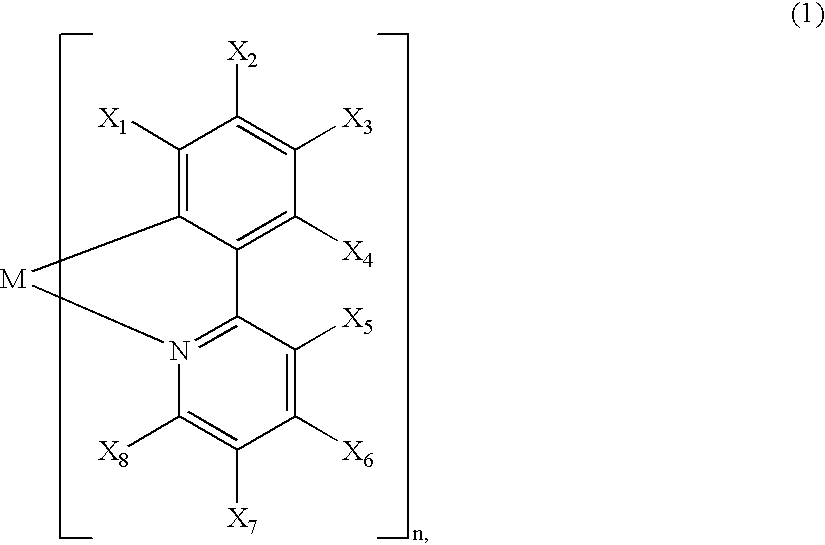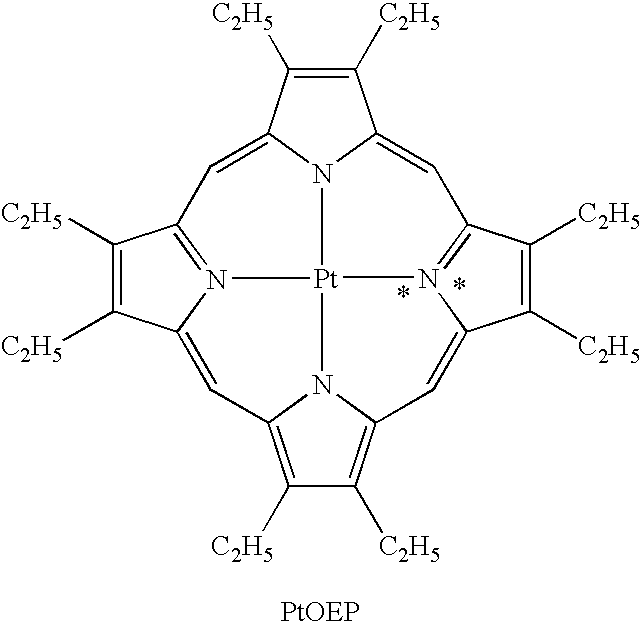Luminescence device, display apparatus and metal coordination compound
a technology of metal coordination compound and luminescence device, which is applied in the direction of discharge tube luminescnet screen, natural mineral layered products, etc., can solve the problems of luminescent deterioration, lowering the resultant luminescence efficiency especially at a higher current density, and it is difficult to expect the resultant el characteristics of phosphorescent materials
- Summary
- Abstract
- Description
- Claims
- Application Information
AI Technical Summary
Benefits of technology
Problems solved by technology
Method used
Image
Examples
examples i-11-i-13
In these examples, metal coordination compounds of formula (1) (Ex. Comp. Nos. (I-1), (I-32) and (I-49) were used in respective luminescence layers for Examples I-11-I-13, respectively.
Each of luminescence devices having a structure shown in FIG. 1C were prepared in the following manner.
On a glass substrate (transparent substrate 15), a 100 nm-thick film (transparent electrode 14) of ITO (indium tin oxide) was formed by sputtering, followed by patterning to have an (opposing) electrode area of 3 mm.sup.2.
On the ITO-formed substrate, three organic layers and two metal electrode layers shown below were successively formed by vacuum (vapor) deposition using resistance heating in a vacuum chamber (10.sup.-4 Pa).
Organic layer 1 (hole transport layer 13) (40 nm): .alpha.-NPD
Organic layer 2 (luminescence layer 12) (20 nm): mixture of CBP: metal coordination compound of formula (1) (93:7 by weight)
Organic layer 3 (exciton diffusion prevention layer 17) (10 nm): BCP
Organic layer 4 (electron ...
example i-14
(Synthesis of Ex. Comp. No. (I-1))
##STR17##
In a 1 liter-three necked flask, 20.0 g (126.6 mM) of 2-bromopyridine, 17.7 g (126.4 mM) of 3-fluorophenylbronic acid, 130 ml of toluene, 65 ml of ethanol and 130 ml of 2M-sodium carbonate aqueous solution were placed and stirred in a nitrogen gas stream at room temperature. Under stirring, to the mixture, 4.60 g (3.98 mM) of tetrakis (triphenyl-phosphine) palladium (0) was added, followed by heat-refluxing for 6 hours under stirring in nitrogen gas stream.
After the reaction, the reaction mixture was cooled, followed by extraction with cool water and toluene. The organic layer was washed with water until the system showed neutral, followed by distilling off of the solvent under reduced pressure to obtain a residue. The residue was purified by silica gel column chromatography (eluent: toluene / ethyl acetate=5 / 1) to obtain 6.0 g of 2-(3-fluorophenyl)pyridine (pale brown liquid) (Yield: 34.6%). ##STR18##
In a 100 ml-four necked flask, 50 ml of g...
example i-15
(Synthesis of Ex. Comp. No. (I-32))
##STR19##
In a 1 liter-three necked flask, 20.8 g (131.6 mM) of 2-bromopyridine, 25.0 g (131.6 mM) of 3-trifluoromethylphenylbronic acid, 130 ml of toluene, 65 ml of ethanol and 130 ml of 2M-sodium carbonate aqueous solution were placed and stirred in a nitrogen gas stream at room temperature. Under stirring, to the mixture, 4.76 g (4.12 mM) of tetrakis (triphenyl-phosphine) palladium (0) was added, followed by heat-refluxing for 7 hours under stirring in nitrogen gas stream.
After the reaction, the reaction mixture was cooled, followed by extraction with cool water and toluene. The organic layer was washed with water until the system showed neutral, followed by distilling off of the solvent under reduced pressure to obtain a residue (pale brown liquid). The residue was purified by silica gel column chromatography (eluent: toluene / hexane=1 / 1) to obtain 6.0 g of 2-(3-trifluoromethylphenyl)pyridine (pale brown liquid) (Yield: 21.1%). ##STR20##
In a 200 ...
PUM
| Property | Measurement | Unit |
|---|---|---|
| thickness | aaaaa | aaaaa |
| brightness | aaaaa | aaaaa |
| peak emission wavelength | aaaaa | aaaaa |
Abstract
Description
Claims
Application Information
 Login to View More
Login to View More - R&D
- Intellectual Property
- Life Sciences
- Materials
- Tech Scout
- Unparalleled Data Quality
- Higher Quality Content
- 60% Fewer Hallucinations
Browse by: Latest US Patents, China's latest patents, Technical Efficacy Thesaurus, Application Domain, Technology Topic, Popular Technical Reports.
© 2025 PatSnap. All rights reserved.Legal|Privacy policy|Modern Slavery Act Transparency Statement|Sitemap|About US| Contact US: help@patsnap.com



